window MERCEDES-BENZ E-CLASS SALOON 2015 User Guide
[x] Cancel search | Manufacturer: MERCEDES-BENZ, Model Year: 2015, Model line: E-CLASS SALOON, Model: MERCEDES-BENZ E-CLASS SALOON 2015Pages: 497, PDF Size: 16.23 MB
Page 42 of 497
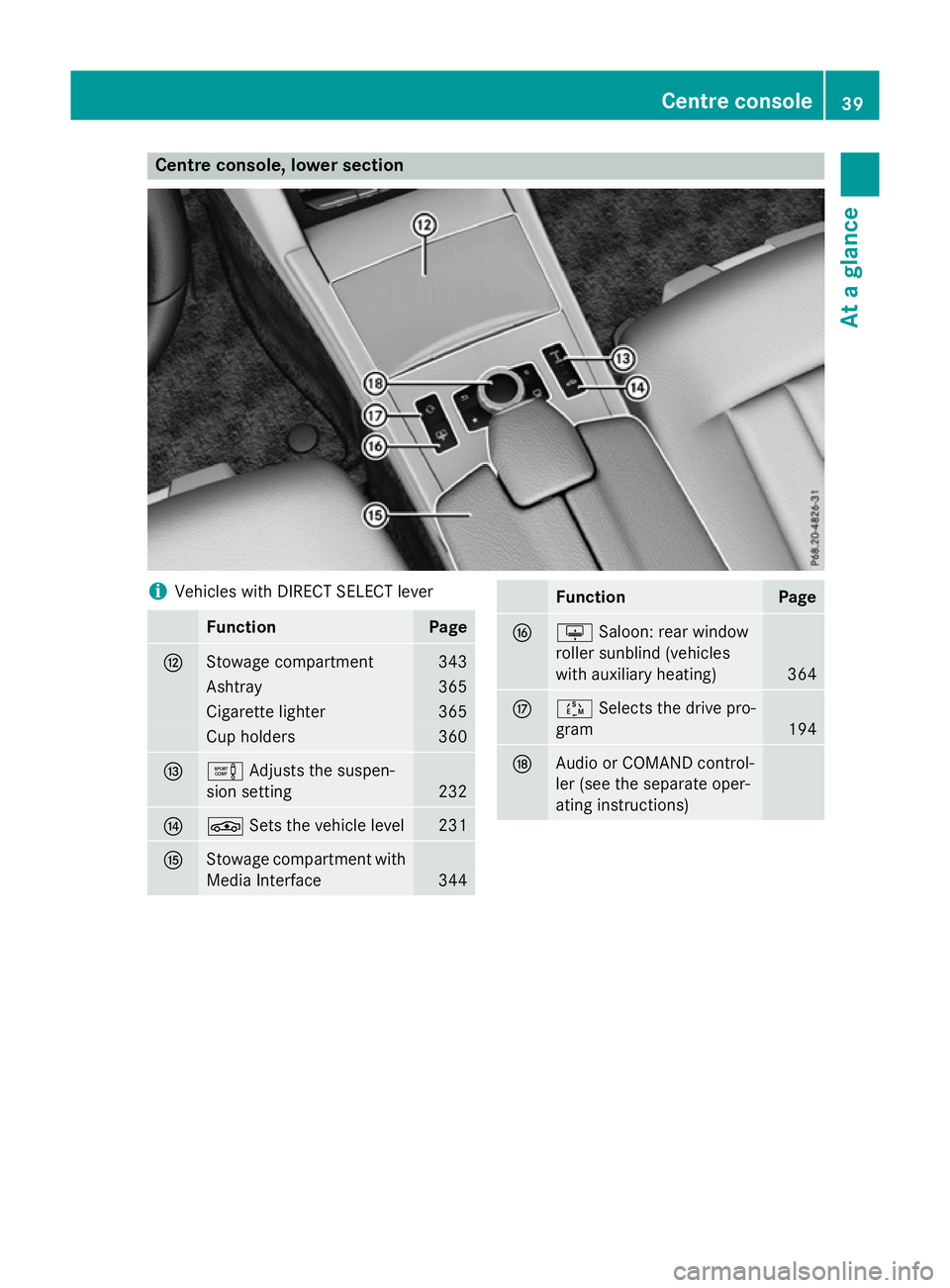
Centre console, lower section
i
Vehicle
swithD IRECT SELECT lever Function Page
H
Stowage compartment 343
Ashtray 365
Cigarett
elighter 365
Cup holders 360
I
e
Adjusts th esuspen-
sion setting 232
J
É
Setsthe vehicle level 231
K
Stowage compartmen
twith
Media Interface 344 Function Page
L
u
Saloon :rear window
roller sunblin d(vehicles
wit ha uxiliary heating) 364
M
Ú
Select sthe driv epro-
gram 194
N
Audi
oorC OMAND control-
ler (see th eseparate oper-
atin ginstructions) Centre console
39Atag lance
Page 45 of 497
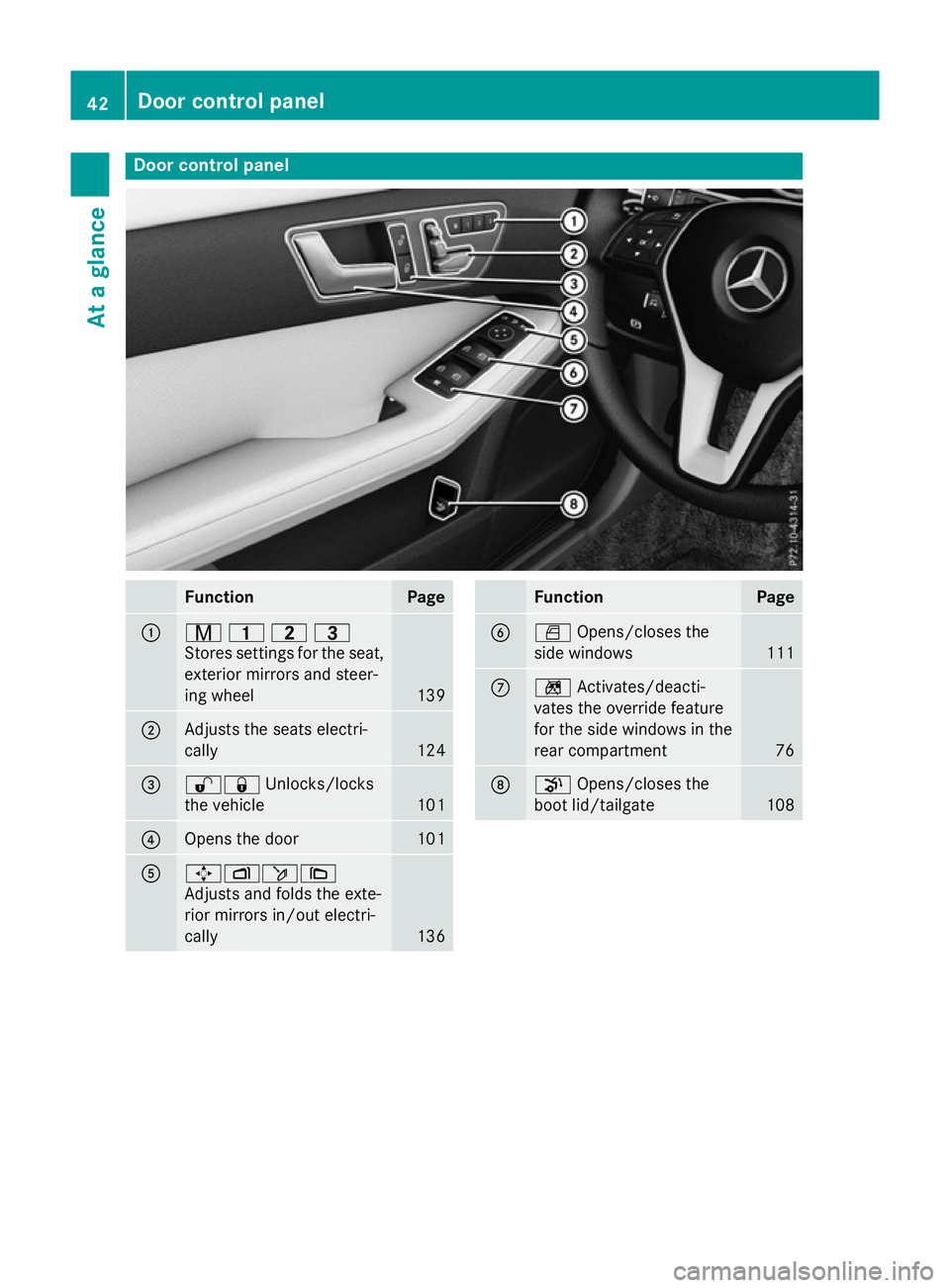
Door contro
lpanel Function Page
:
r
45=
Store ssettings for the seat,
exterio rmirrors and steer-
ing wheel 139
;
Adjusts the seats electri-
cally
124
=
%&
Unlocks/locks
the vehicle 101
?
Opens the door 101
A
7Zö
\
Adjusts and folds the exte-
rio rm irrors in/out electri-
cally 136 Function Page
B
W
Opens/close sthe
sid ew indows 111
C
n
Activates/deacti-
vate sthe override feature
for the sid ewindow sint he
rea rcompartment 76
D
p
Opens/close sthe
boo tlid/tailgate 10842
Door control panelAt
ag lance
Page 53 of 497
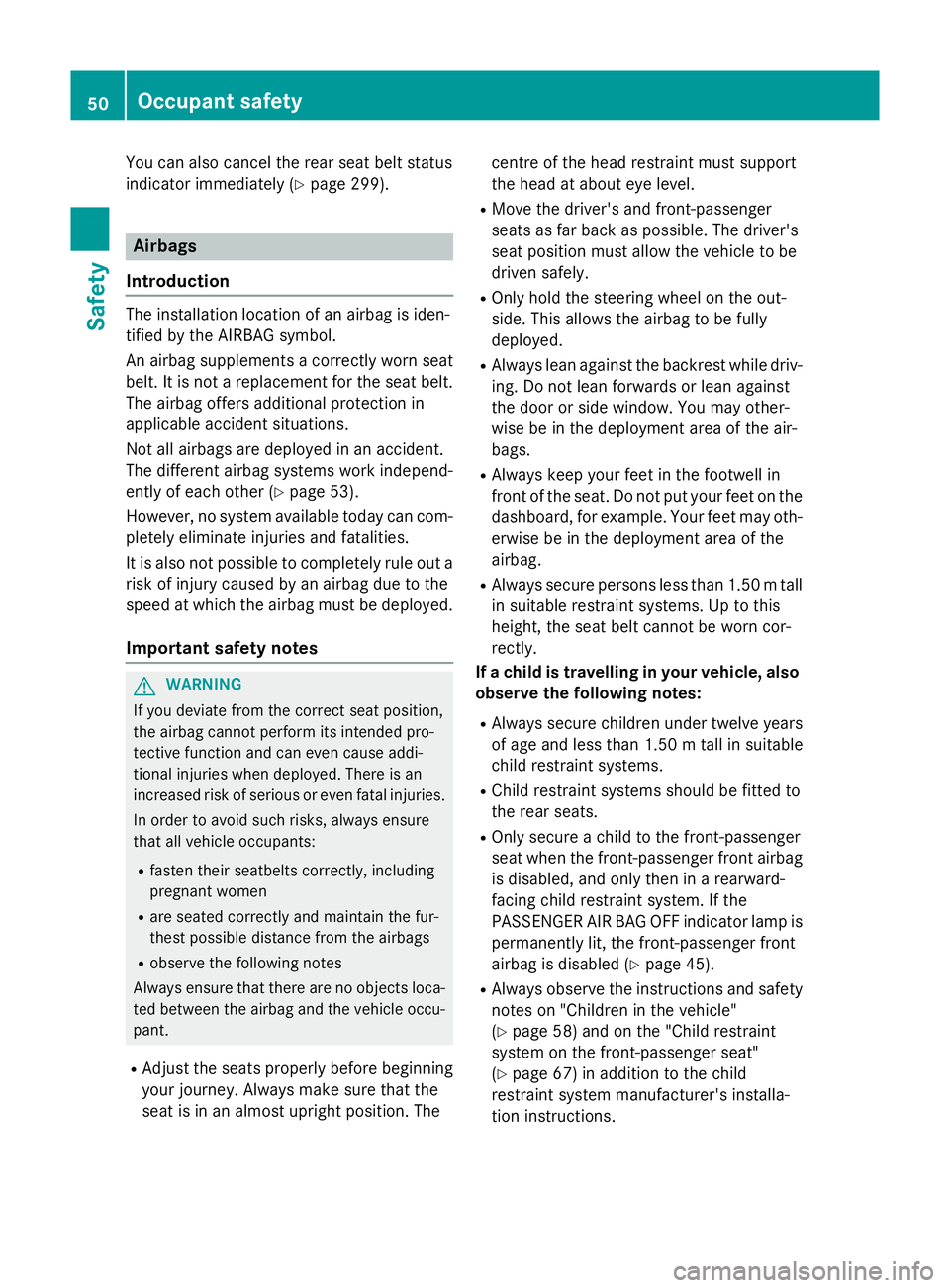
You can also cancel the rear seat belt status
indicator immediately (Y page 299).Airbags
Introduction The installation location of an airbag is iden-
tified by the AIRBA Gsymbol.
An airbag supplements acorrectly worn seat
belt. It is not areplacemen tfor the seat belt.
The airbag offers additional protection in
applicable accident situations.
Not all airbags are deployed in an accident.
The differen tairbag systems work independ-
ently of each other (Y page 53).
However, no system available today can com- pletely eliminate injuries and fatalities.
It is also not possible to completely rule out a
risk of injury caused by an airbag due to the
speed at which the airbag must be deployed.
Important safet ynotes G
WARNING
If you deviat efromt he correc tseat position,
the airbag cannot perform its intended pro-
tectiv efunction and can even cause addi-
tional injuries when deployed. There is an
increased risk of serious or even fatal injuries.
In order to avoid such risks, always ensure
that all vehicle occupants:
R fasten their seatbelts correctly, including
pregnant women
R are seate dcorrectly and maintain the fur-
thest possible distanc efromt he airbags
R observe the followin gnotes
Always ensure that there are no object sloca-
ted betwee nthe airbag and the vehicle occu-
pant.
R Adjust the seats properly befor ebeginning
your journey. Always make sure that the
seat is in an almost upright position. The centr
eofthe head restraint must support
the head at about eye level.
R Move the driver's and front-passenger
seats as far back as possible. The driver's
seat position must allow the vehicle to be
drive nsafely.
R Only hold the steerin gwheel on the out-
side. This allows the airbag to be fully
deployed.
R Always lean against the backrest while driv-
ing. Do not lean forwards or lean against
the door or side window. You may other-
wise be in the deploymen tarea of the air-
bags.
R Always keep your feet in the footwell in
front of the seat. Do not put your feet on the
dashboard ,for example. Your feet may oth-
erwise be in the deploymen tarea of the
airbag.
R Always secur epersons less than 1.50 mtall
in suitable restraint systems .Uptothis
height ,the seat belt canno tbeworn cor-
rectly.
If ac hild is travelling in you rvehicle, also
observe th efollowing notes:
R Always secure childre nunde rtwelve years
of age and less than 1.50 mtall in suitable
child restraint systems.
R Child restraint systems should be fitte dto
th er ear seats.
R Only secure achild to th efront-pa ssenger
seat when th efront-pa ssenger fron tairbag
is disabled, and only then in arearward-
facing child restraint system. If the
PASSENGER AI RBAG OFFindicator lamp is
permanently lit ,the front-passenger front
airbag is disabled (Y page 45).
R Always observ ethe instruction sand safety
note son" Children in th evehicle"
(Y page 58) and on th e"Child restraint
system on th efront-pa ssenger seat"
(Y page 67 )inaddition to th echild
restraint system manufacturer' sinstalla-
tio ninstructions. 50
Occupant safetySafety
Page 54 of 497
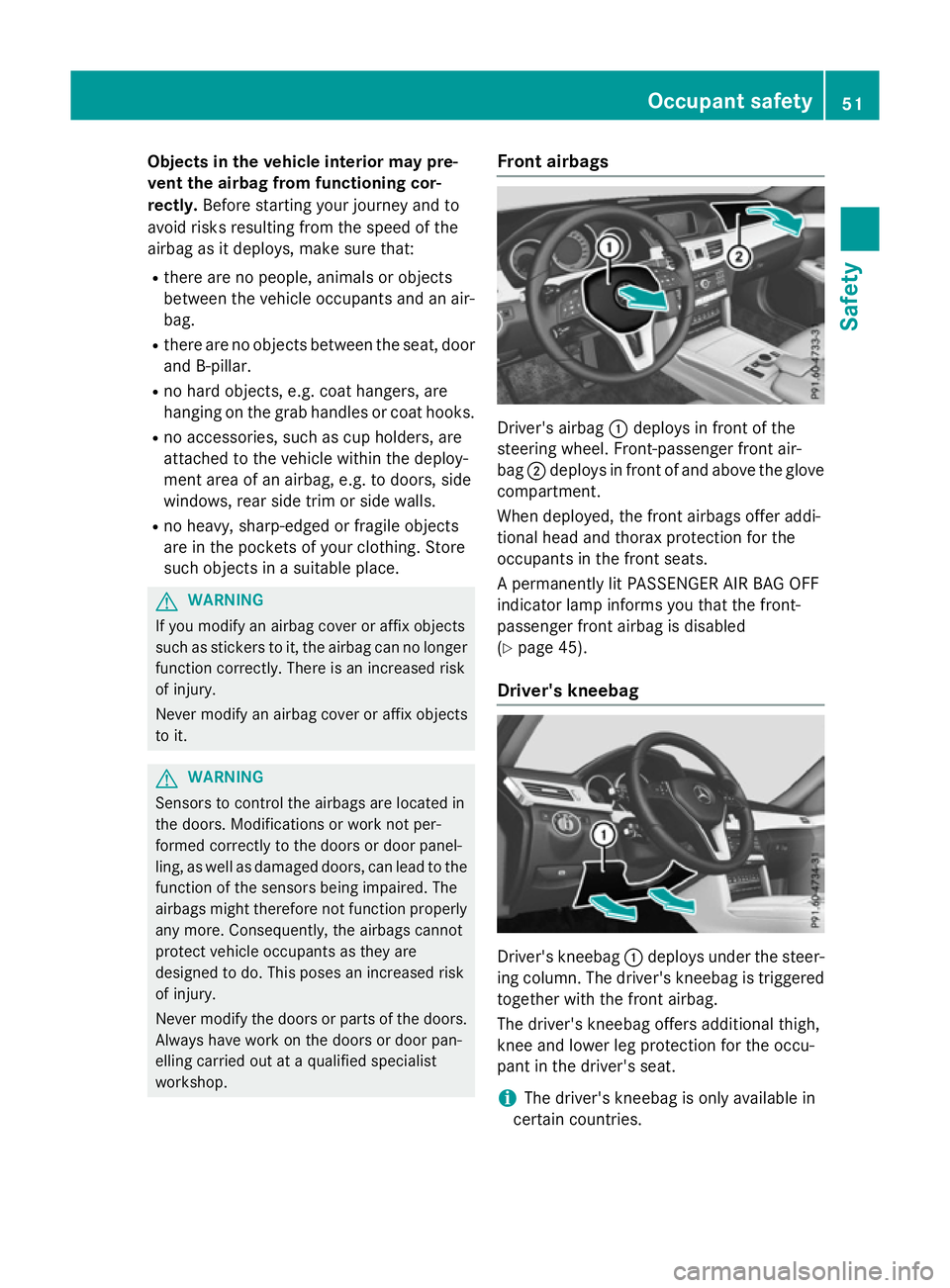
Objects in the vehicle interior may pre-
vent the airba gfrom functioning cor-
rectly. Beforestarting your journey and to
avoid risks resulting from the speed of the
airbag as it deploys, make sure that:
R there are no people, animals or objects
between the vehicle occupant sand an air-
bag.
R there are no objects between the seat, door
and B-pillar.
R no hard objects, e.g. coat hangers, are
hanging on the grab handles or coat hooks.
R no accessories, such as cup holders, are
attached to the vehicle within the deploy-
ment area of an airbag, e.g. to doors, side
windows, rear side trim or side walls.
R no heavy, sharp-edged or fragile objects
are in the pockets of your clothing. Store
such objects in asuitable place. G
WARNING
If you modify an airbag cover or affix objects
such as stickers to it, the airbag can no longer function correctly. There is an increased risk
of injury.
Never modify an airbag cover or affix objects
to it. G
WARNING
Sensors to control the airbags are located in
the doors. Modification sorwork not per-
formed correctly to the doors or door panel-
ling, as well as damaged doors, can lead to the function of the sensor sbeing impaired. The
airbags might therefore not function properly any more. Consequently, the airbags cannot
protec tvehicle occupant sasthey are
designed to do. This poses an increased risk
of injury.
Never modify the doors or parts of the doors.
Always have work on the doors or door pan-
elling carried out at aqualified specialist
workshop. Front airbags
Driver's airbag
:deploys in fron tofthe
steerin gwheel. Front-passenger fron tair-
bag ;deploys in fron tofand above the glove
compartment.
When deployed, the fron tairbags offer addi-
tional head and thorax protection for the
occupant sinthe fron tseats.
Ap ermanently lit PASSENGER AIR BAG OFF
indicator lamp informs you that the front-
passenger fron tairbag is disabled
(Y page 45).
Driver's kneebag Driver's kneebag
:deploys under the steer-
ing column. The driver's kneebag is triggered
together with the fron tairbag.
The driver's kneebag offers additional thigh,
knee and lower leg protection for the occu-
pant in the driver's seat.
i The driver's kneebag is only available in
certain countries. Occupant safety
51Safety Z
Page 55 of 497
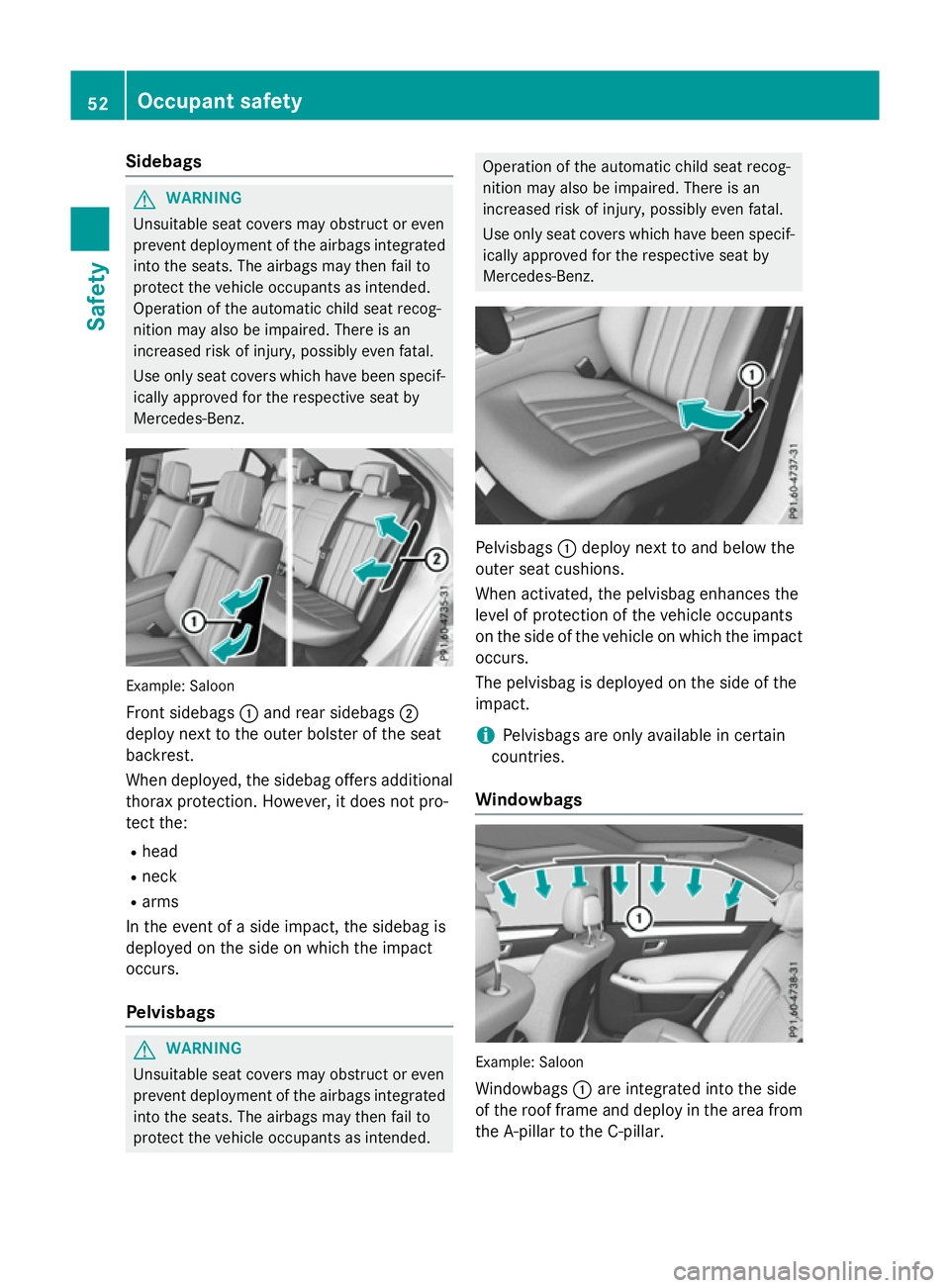
Sidebags
G
WARNING
Unsuitable seat covers may obstruct or even
prevent deployment of the airbags integrated into the seats. The airbags may then fail to
protect the vehicle occupants as intended.
Operation of the automatic child seat recog-
nition may also be impaired. There is an
increased risk of injury, possibly even fatal.
Use only seat covers which have been specif-
ically approved for the respective seat by
Mercedes-Benz. Example: Saloon
Front sidebags :and rear sidebags ;
deploy next to the outer bolster of the seat
backrest.
When deployed, the sidebag offers additional thorax protection. However, it does not pro-
tect the:
R head
R neck
R arms
In the event of aside impact, the sidebag is
deployed on the side on which the impact
occurs.
Pelvisbags G
WARNING
Unsuitable seat covers may obstruct or even
prevent deployment of the airbags integrated into the seats. The airbags may then fail to
protect the vehicle occupants as intended. Operation of the automatic child seat recog-
nition may also be impaired. There is an
increased risk of injury, possibly even fatal.
Use only seat covers which have been specif- ically approved for the respective seat by
Mercedes-Benz. Pelvisbags
:deploy next to and below the
outer seat cushions.
When activated, the pelvisbag enhances the
level of protection of the vehicle occupants
on the side of the vehicle on which the impact
occurs.
The pelvisbag is deployed on the side of the
impact.
i Pelvisbags are only available in certain
countries.
Windowbags Example: Saloon
Windowbags :are integrated into the side
of the roof frame and deploy in the area from the A-pillar to the C-pillar. 52
Occupant safetySafety
Page 56 of 497
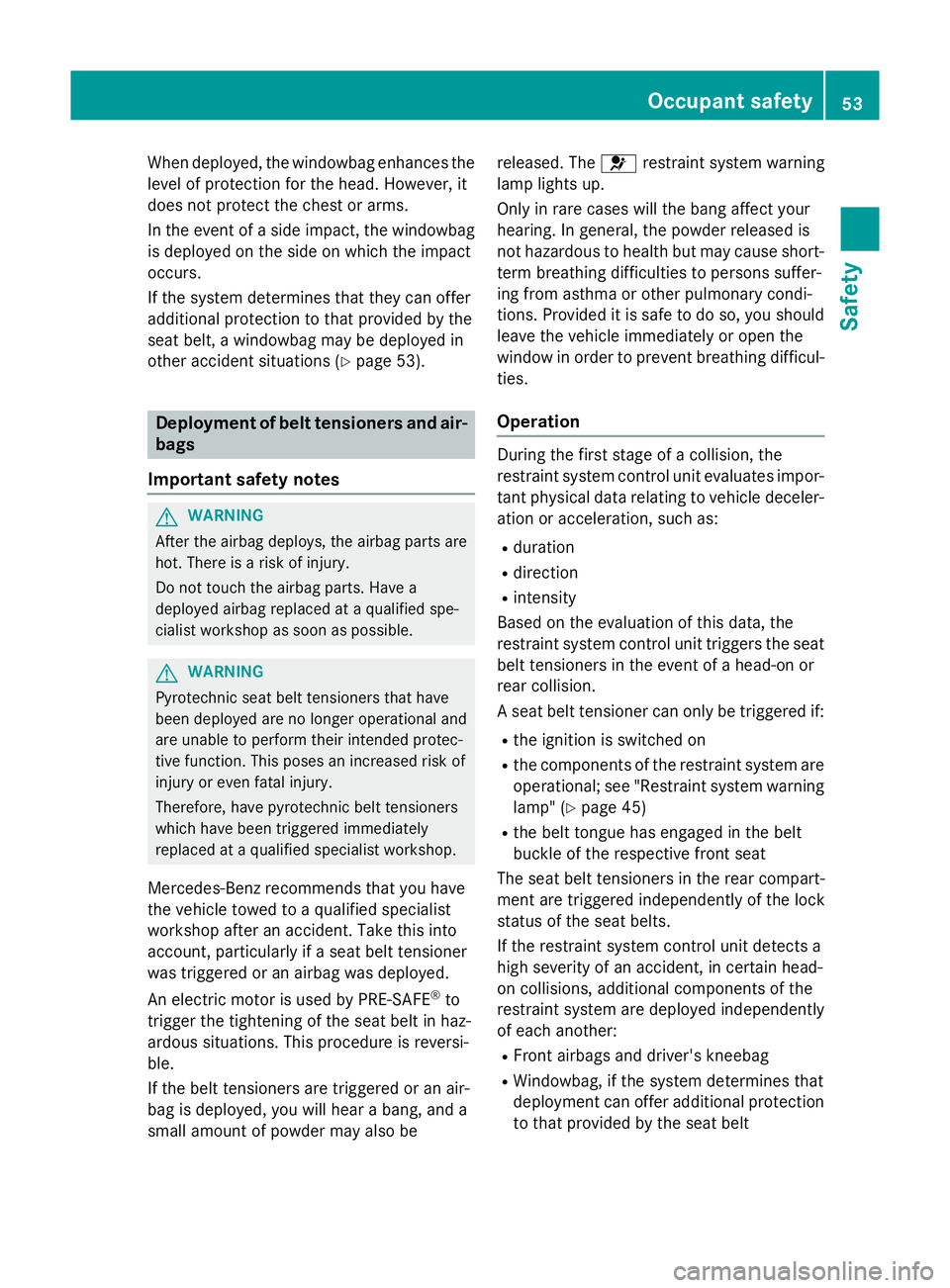
When deployed, the windowbag enhances the
level of protection for the head. However, it
does not protec tthe chest or arms.
In the event of aside impact, the windowbag
is deployed on the side on which the impact
occurs.
If the system determines that they can offer
additional protection to that provided by the
seat belt, awindowbag may be deployed in
other accident situation s(Ypage 53). Deployment of belt tensioners and air-
bags
Important safety notes G
WARNING
After the airbag deploys, the airbag parts are
hot. There is arisk of injury.
Do not touch the airbag parts. Have a
deployed airbag replaced at aqualified spe-
cialist workshop as soon as possible. G
WARNING
Pyrotechnic seat belt tensioners that have
been deployed are no longer operational and
are unable to perform their intended protec-
tive function. This poses an increased risk of
injury or even fatal injury.
Therefore, have pyrotechnic belt tensioners
which have been triggered immediately
replaced at aqualified specialist workshop.
Mercedes-Benz recommends that you have
the vehicle towed to aqualified specialist
workshop after an accident .Take this into
account ,particularly if aseat belt tensioner
was triggered or an airbag was deployed.
An electric motor is used by PRE-SAFE ®
to
trigger the tightening of the seat belt in haz-
ardous situations. This procedure is reversi-
ble.
If the belt tensioners are triggered or an air-
bag is deployed, you will hear abang, and a
small amount of powder may also be released. The
6restraint system warning
lamp lights up.
Only in rare cases will the bang affect your
hearing. In general, the powder released is
not hazardous to health but may cause short- term breathin gdifficulties to persons suffer-
ing from asthma or other pulmonary condi-
tions. Provided it is safe to do so, you should
leave the vehicle immediately or open the
window in order to preven tbreathin gdifficul-
ties.
Operation During the first stage of
acollision, the
restraint system control unit evaluates impor-
tant physical data relating to vehicle deceler- ation or acceleration, such as:
R duration
R direction
R intensity
Based on the evaluation of this data, the
restraint system control unit trigger sthe seat
belt tensioners in the event of ahead-on or
rear collision.
As eat belt tensioner can only be triggered if:
R the ignition is switched on
R the componentsoft he restraint system are
operational; see "Restraint system warning lamp" (Y page 45)
R the belt tongue has engaged in the belt
buckle of the respective fron tseat
The seat belt tensioners in the rear compart-
ment are triggered independently of the lock
status of the seat belts.
If the restraint system control unit detect sa
high severit yofanaccident,incertain head-
on collisions, additional componentsoft he
restraint system are deployed independently
of each another:
R Fron tairbags and driver's kneebag
R Windowbag, if the system determines that
deployment can offer additional protection
to that provided by the seat belt Occupant safety
53Safety Z
Page 57 of 497
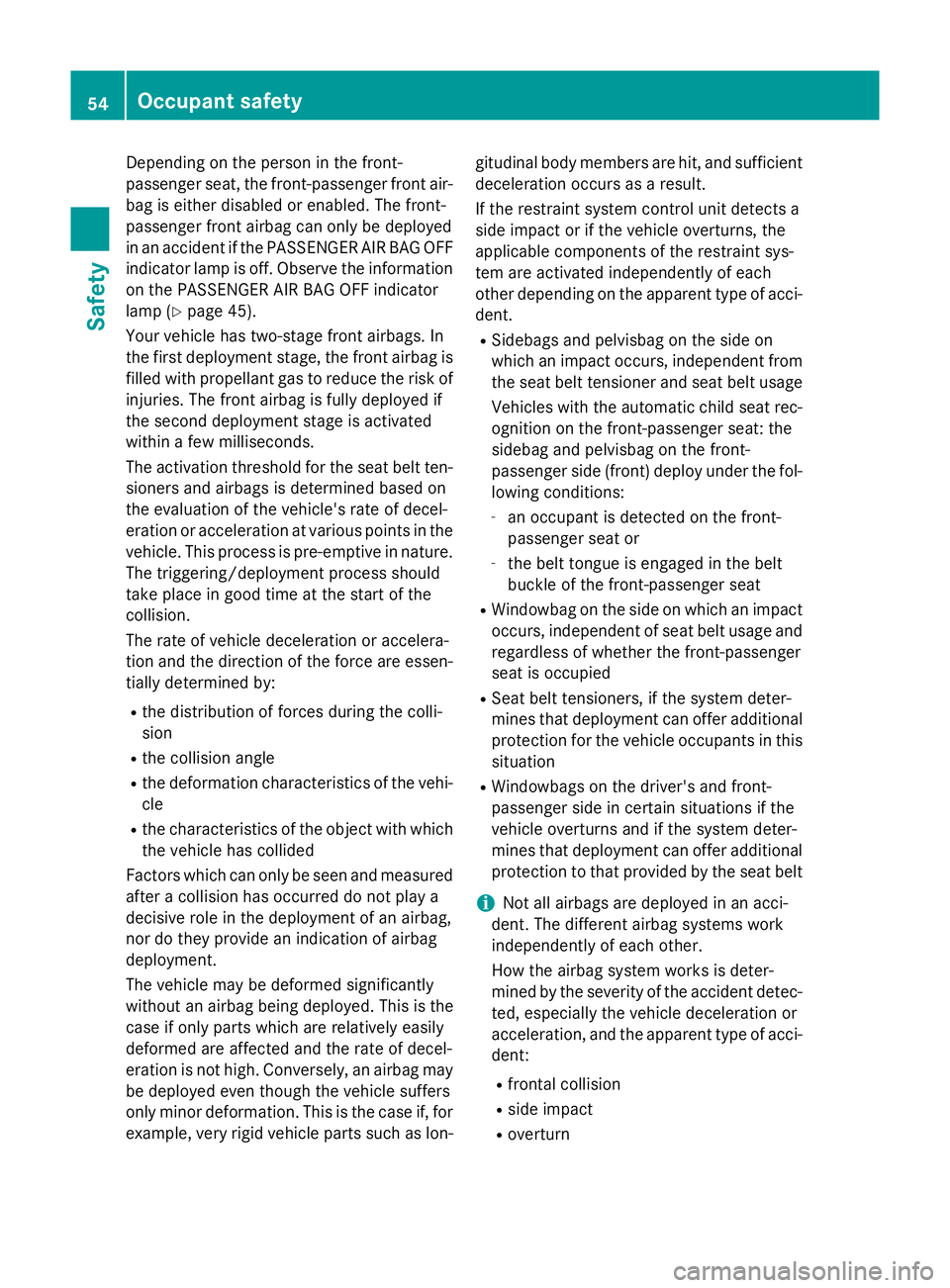
Depending on the perso
ninthe front-
passenge rsea t, the front-passenge rfront air-
ba gise ithe rd isable dorenabled .The front-
passenge rfront airba gcan onl ybedeployed
in an accident if the PASSENGER AIR BAG OFF indicator lamp is off .Obser ve the information
on the PASSENGER AIR BAG OFF indicator
lamp (Y page 45).
Your vehicl ehastwo-stage front airbags. In
the first deployment stage ,the front airba gis
fille dwithp ropellant ga storeduce the risk of
injuries .The front airba gisfullydeployed if
the second deployment stage is activated
withi nafew milliseconds.
Th ea ctivatio nthreshold for the seat belt ten-
sioners and airbags is determine dbased on
the evaluation of the vehicle' srateofd ecel-
eratio noracceleratio natvarious points in the
vehicle. This proces sispre-emptiv einnature.
Th et riggering/deployment proces sshould
take place in good tim eatthe start of the
collision.
Th er ateofv ehicledeceleratio noraccelera-
tio na nd the directio nofthe force ar eessen-
tiall ydetermine dby:
R the distributio nofforces during the colli-
sion
R the collision angle
R the deformatio ncharacteristics of the vehi-
cle
R the characteristics of the object with which
the vehicl ehascollided
Factors which can onl ybeseena nd measured
after acollision ha soccurre ddonot play a
decisiv eroleint he deployment of an airbag,
nor do the yprovide an indicatio nofairbag
deployment.
Th ev ehicl emaybe deformed significantly
without an airba gbeing deployed .Thisist he
cas eifo nlyp arts which ar erelativel yeasily
deformed ar eaffecte dand the rate of decel-
eratio nisn ot high .Conversely ,anairba gm ay
be deployed eve nthoug hthe vehicl esuffers
onl ym inor deformation. This is the cas eif, for
example, ver yrigid vehicl eparts such as lon- gitudina
lbod ym embers ar ehit,a nd sufficient
deceleratio noccurs as aresult.
If the restraint syste mcontro lunitd etects a
side impact or if the vehicl eoverturns, the
applicabl ecomponents of the restraint sys-
tem ar eactivated independentl yofeach
other depending on the apparent typ eofacci-
dent.
R Sidebag sand pelvisba gonthe side on
which an impact occurs, independent from the seat belt tensioner and seat belt usage
Vehicle switht he automatic child seat rec-
ognition on the front-passenge rseat: the
sideba gand pelvisba gonthe front-
passenge rside( front) deploy under the fol-
lowing conditions:
- an occupant is detecte donthe front-
passenge rseator
- the belt tongue is engaged in the belt
buckle of the front-passenge rseat
R Windowbag on the side on which an impact
occurs, independent of seat belt usag eand
regardles sofwhether the front-passenger
seat is occupied
R Sea tbeltt ensioners ,ifthe syste mdeter-
mines tha tdeployme nt can offer additional
protection for the vehicl eoccupants in this
situation
R Windowbag sonthe driver's and front-
passenge rsideinc ertainsituations if the
vehicl eoverturns and if the syste mdeter-
mines tha tdeployme nt can offer additional
protection to tha tprovide dbythe seat belt
i Not al
lairbags ar edeployed in an acci-
dent. Th edifferent airba gsystems work
independentl yofeacho ther.
How the airba gsystemw orks is deter-
mined by the severity of the accident detec- ted ,especially the vehicl edeceleratio nor
acceleration, and the apparent typ eofacci-
dent:
R frontal collision
R side impact
R overturn 54
Occupant safetySafety
Page 59 of 497
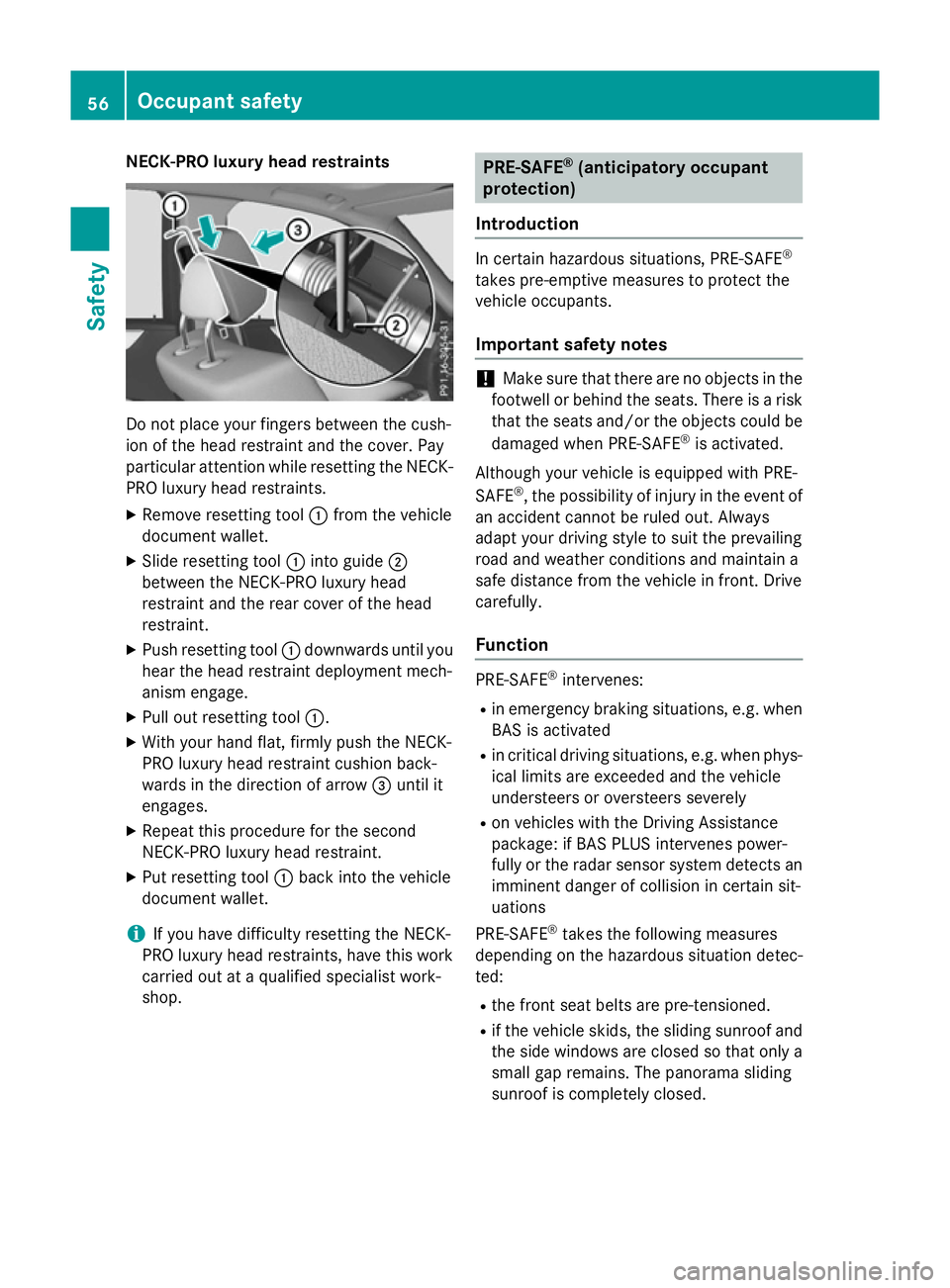
NECK-PRO luxury head restraints
Do not place your fingers between the cush-
io noft he head restraint and the cover. Pay
particular attentio nwhile resetting the NECK-
PR Ol uxuryh eadr estraints.
X Remov eresetting tool :fromt he vehicle
document wallet.
X Slide resetting tool :into guide ;
between the NECK-PR Oluxuryh ead
restraint and the rea rcove roft he head
restraint.
X Push resetting tool :downwards unti lyou
hear the head restraint deployment mech-
anism engage.
X Pull ou tresetting tool :.
X With your hand flat, firml ypusht he NECK-
PR Ol uxuryh eadr estraint cushion back-
wards in the direction of arrow =unti lit
engages.
X Repeat thi sprocedur efor the second
NECK-PR Oluxuryh eadr estraint.
X Pu tresetting tool :back into the vehicle
document wallet.
i If yo
uhaved ifficulty resetting the NECK-
PR Ol uxuryh eadr estraints ,havet hisw ork
carried ou tataqualified specialis twork-
shop. PRE-SAFE
®
(anticipatory occupant
protection)
Introduction In certain hazardous situations, PRE-SAFE
®
take spre-emptive measures to protect the
vehicl eoccupants.
Important safety notes !
Make sure tha
tthere ar enoobjects in the
footwell or behind the seats .The re is arisk
tha tthe seats and/or the objects could be
damage dwhenP RE-SAFE ®
is activated.
Although your vehicl eisequippe dwithP RE-
SAFE ®
,t he possibility of injury in the event of
an accident cannot be rule dout.A lways
adap tyou rd rivin gstyle to suit the prevailing
roa dand weather conditions and maintain a
safe distance fro mthe vehicl einfront. Drive
carefully.
Function PRE-SAFE
®
intervenes:
R in emergency braking situations, e.g .when
BAS is activated
R in critica ldrivin gsituations, e.g .whenp hys-
ica llimit sareexceeded and the vehicle
understeers or oversteers severely
R on vehicles with the Driving Assistance
package: if BAS PLU Sintervenes power-
full yort he rada rsen sor syste mdetects an
imminent dange rofcollision in certain sit-
uations
PRE-SAFE ®
take sthe following measures
depending on the hazardous situatio ndetec-
ted:
R the front seat belts ar epre-tensioned.
R if the vehicl eskids ,the sliding sunroo fand
the side windows ar eclose dsot hato nlya
small ga premains. Th epanorama sliding
sunroo fiscompletel yclosed. 56
Occupant safetySafety
Page 61 of 497
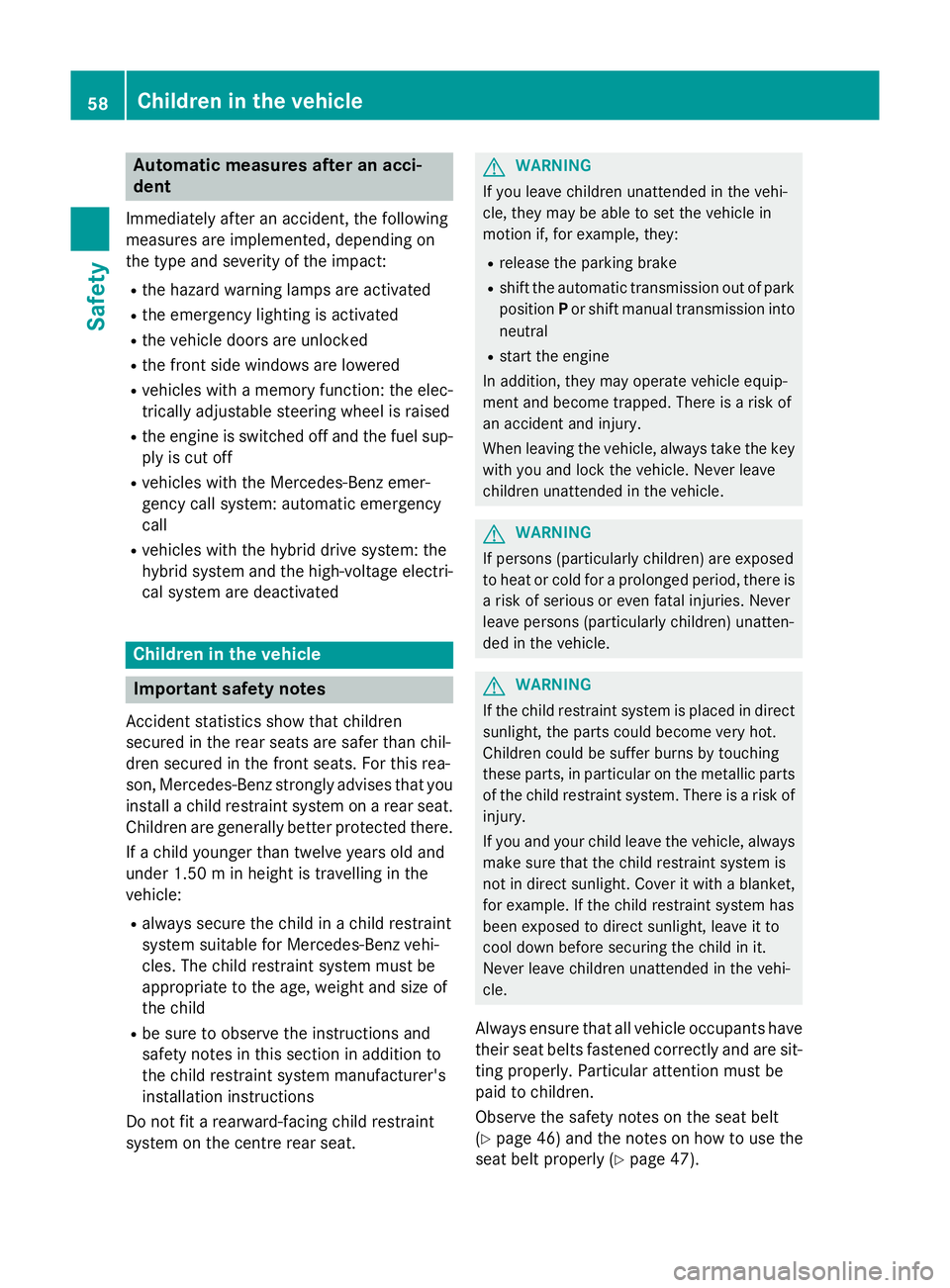
Automati
cmeasures after an acci-
dent
Immediately after an accident, th efollowing
measures are implemented, depending on
th et ypea nd severity of th eimpact:
R theh azard warning lamp sare activated
R thee mergenc ylighting is activated
R thev ehicl edoor sare unlocked
R thef ront side windows are lowered
R vehicles wit hamemory function :the elec-
trically adjustable steering whee lisraised
R thee ngineiss witched off and th efuel sup-
ply is cut off
R vehicles wit hthe Mercedes-Benz emer-
gency call system: automatic emergency
call
R vehicles wit hthe hybrid driv esystem: the
hybrid system and th ehigh-voltage electri-
cal system are deactivated Children in th
evehicle Important safety notes
Acciden tstatistics sho wthatc hildren
secured in th erear seat sare safer than chil-
dre nsecured in th efront seats. Fo rthisr ea-
son ,Mercedes-Benz strongly advises that you
instal lachild restrain tsystem on arear seat.
Children are generally bette rprotected there.
If ac hild younger than twelve years old and
under 1.50 minh eight is travellin ginthe
vehicle:
R always secure th echild in achild restraint
system suitable for Mercedes-Benz vehi-
cles. The child restrain tsystem mus tbe
appropriat etotheage, weigh tand siz eof
th ec hild
R be sur etoobservethe instruction sand
safet ynotes in this section in addition to
th ec hild restrain tsystem manufacturer's
installation instructions
Do no tfitar earward-facing child restraint
system on th ecentre rear seat. G
WARNING
If you leav echildren unattended in th evehi-
cle ,the ym ay be able to set th evehicl ein
motion if, for example, they:
R release th eparking brake
R shif tthe automatic transmission out of park
position Por shif tmanual transmission into
neutral
R start th eengine
In addition ,the ym ay operate vehicl eequip-
men tand become trapped .There is ariskof
an acciden tand injury.
When leaving th evehicle, always tak ethe key
wit hyou and loc kthe vehicle. Never leave
children unattended in th evehicle. G
WARNING
If person s(particularly children )are exposed
to heat or cold for aprolonged period, there is
ar iskofs erious or eve nfatal injuries. Never
leav eperson s(particularly children )unatten-
ded in th evehicle. G
WARNING
If th echild restrain tsystem is placed in direct
sunlight, th epartsc ould become ver yhot.
Children could be suffer burn sbytouching
these parts, in particular on th emetallic parts
of th echild restrain tsystem. There is ariskof
injury.
If you and your child leav ethe vehicle, always
mak esuret hatthe child restrain tsystem is
no tind irectsunlight. Cove ritwithab lanket,
for example. If th echild restrain tsystem has
been exposed to direc tsunlight, leav eitto
cool down before securin gthe child in it.
Never leav echildren unattended in th evehi-
cle.
Always ensur etha tall vehicl eoccupant shave
their seat belt sfastene dcorrectly and are sit-
ting properly. Particular attention mus tbe
paid to children.
Observ ethe safet ynotes on th eseat belt
(Y page 46) and th enotes on how to use the
seat belt properly (Y page 47).58
Childre
ninthevehicleSafety
Page 69 of 497
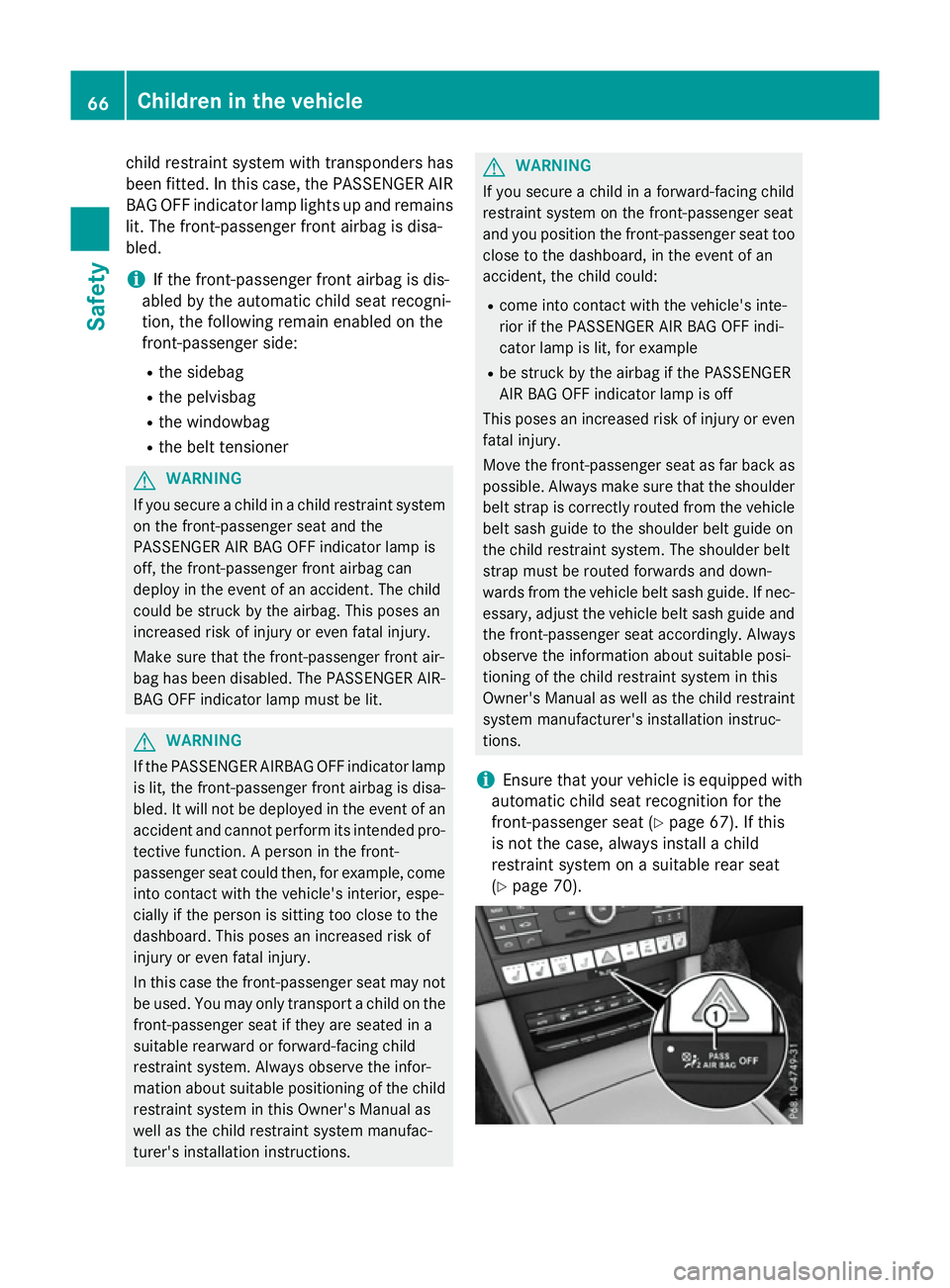
chil
drestraint system with transponders has
bee nfitted .Inthis case, the PASSENGER AIR
BAG OFF indicator lamp lights up and remains
lit. The front-passenger front airba gisdisa-
bled.
i If the front-passenger front airba gisdis-
able dbyt he automatic chil dseatrecogni-
tion, the following remain enabled on the
front-passenger side:
R the sidebag
R the pelvisbag
R the windowbag
R the bel ttensioner G
WARNING
If yo usecure achildinac hildr estraint system
on the front-passenger sea tand the
PASSENGER AIR BAG OFF indicator lamp is
off, the front-passenger front airba gcan
deploy in the event of an accident. The child
could be struck by the airbag. Thi sposes an
increased ris kofinjury or eve nfata linjury.
Make sure that the front-passenger front air-
ba gh asbee ndisable d. The PASSENGER AIR-
BAG OFF indicator lamp mus tbelit. G
WARNING
If the PASSENGER AIRBAG OFF indicator lamp is lit, the front-passenger front airba gisdisa-
bled. It will not be deployed in the event of an
accident and cannot perform its intended pro-
tectiv efunction. Aperson in the front-
passenger sea tcould then, for example, come
into contact with the vehicle's interior ,espe-
ciall yift he person is sitting too clos etothe
dashboard. Thi sposes an increased ris kof
injury or eve nfata linjury.
In this cas ethe front-passenger sea tmay not
be used. You may only transpor tachildont he
front-passenger sea tifthey are seated in a
suitabl erearward or forward-facing child
restraint system. Alway sobserve the infor-
mation abou tsuitabl epositioning of the child
restraint system in this Owner's Manua las
well as the chil drestraint system manufac-
turer's installation instructions. G
WARNING
If yo usecure achildinaf orward-facing child
restraint system on the front-passenger seat
and yo uposition the front-passenger sea ttoo
close to the dashboard, in the event of an
accident, the chil dcould:
R come into contact with the vehicle's inte-
rio rift he PASSENGER AIR BAG OFF indi-
cator lamp is lit, for example
R be struck by the airba gifthe PASSENGER
AIR BAG OFF indicator lamp is off
Thi sposes an increased ris kofinjury or even
fata linjury.
Move the front-passenger sea tasfar back as
possible .Alway smake sure that the shoulder
bel tstra pisc orrectly routed from the vehicle
bel tsashg uide to the shoulder bel tguide on
the chil drestraint system. The shoulder belt
stra pmustb erouted forward sand down-
wards from the vehicle bel tsashg uide .Ifnec-
essary ,adjust the vehicle bel tsashg uide and
the front-passenger sea taccordingly .Always
observe the information abou tsuitabl eposi-
tioning of the chil drestraint system in this
Owner's Manua laswellast he chil drestraint
system manufacturer' sinstallation instruc-
tions.
i Ensur
ethat your vehicle is equipped with
automatic chil dseatrecognition for the
front-passenger sea t(Ypage 67). If this
is not the case, always install achild
restraint system on asuitabl erears eat
(Y page 70). 66
Childre
ninthe vehicleSafety